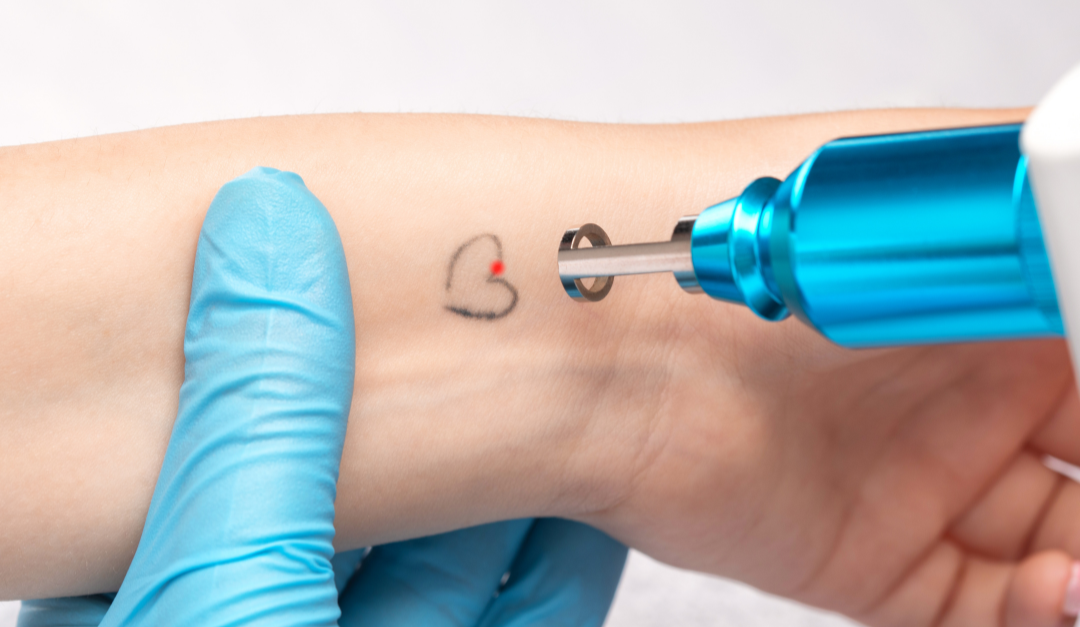Tattoo removal typically involves the use of laser technology, though alternative methods like dermabrasion (which sands off the top layers of skin) and surgical excision (cutting out the tattooed skin) are also used. Laser removal is the most common method, utilizing high-intensity light beams to break down the ink particles embedded in the skin. These fragmented particles are then gradually absorbed and eliminated by the body’s lymphatic system.
Each method has its own set of considerations and potential risks:
- Laser Removal: It can cause skin discoloration, blistering, and scarring. The procedure requires multiple sessions for effective results and can be more painful than other methods.
- Dermabrasion: It may lead to significant skin irritation, infection, and substantial healing time. This method is less common due to its invasive nature.
- Surgical Excision: It can result in noticeable scarring and potential complications from surgery, such as infection and extended recovery periods. This technique is generally reserved for small tattoos.
Permanent tattoos can be hard and painful to remove. Removal may also require multiple treatments, ranging from 6 to 12 sessions, and the costs can vary significantly, typically ranging from $200 to $500 per session depending on the size and color of the tattoo. With respect to laser removal, specifically, location on the body, depth of the ink and color have significant impacts on the duration of the process. In general, it is more difficult to remove colored ink. Additionally, most providers require patients to wait for a period of 6-8 weeks in between sessions; patients typically do not see results for many months, which can be discouraging and lead to patient-retention issues.
Nevertheless, tattoo removal is becoming increasingly popular. Like other aesthetic procedures, not only does removal help patients achieve a better look, but it affects them on an emotional level as well, which is a major draw to the industry.
Patients must understand the risks, benefits, and involved process for each method before proceeding with tattoo removal.
Legal Guidelines for Tattoo Removal
There are several options for tattoo removal, which include:
- Laser Removal: The FDA has approved certain laser devices to remove tattoos. Lighter colors such as yellow, green, and red are more difficult to remove than darker colors such as dark blue and black. It may take between 6 to 10 treatments to remove a tattoo, depending on various factors such as the size and color of the tattoo. Potential side effects may include bleeding, redness, soreness, blistering, pigmentation changes, and scarring. Patients are advised to follow post-treatment care instructions provided by their healthcare professional.
- Surgery: Surgery encompasses both surgical-excision and dermabrasion methods. Tattoos can sometimes be removed by surgical excision, which involves cutting out the tattooed skin and then sewing the skin back together. Other times, dermabrasion can be used, which involves sanding down the skin to remove the tattoo. Either way, there will be some scarring, and proper aftercare, including wound cleaning and protective dressings, is essential to prevent infections and minimize scarring.
- Ointments and Creams: The FDA has not approved tattoo removal ointments, creams, or do-it-yourself tattoo removal kits. These products may cause skin rashes, burns, or scars.
Regulation of Laser Devices for Tattoo Removal
The FDA also regulates laser devices used to remove tattoos. The FDA has cleared the marketing of several types of lasers for tattoo lightening or removal. The lasers are cleared for use by, or under the supervision of, a healthcare professional. Laser tattoo removal requires using the correct type of laser, understanding the reaction of tissue to the laser, and knowing how to treat the area after the procedure. Compliance with FDA regulations is mandatory, and failure to do so may result in penalties including fines, product seizures, or other legal actions.
The type of laser used to remove a tattoo depends on the tattoo’s colors. Because different colors of ink absorb different wavelengths of light at varying efficiencies, multi-colored tattoos may require the use of multiple lasers. Colors such as green, red, and yellow are the hardest colors to remove, while dark blue and black are the easiest. Flesh-colored tattoos, white ink (which isn’t actually ink but is hydrogen peroxide), and permanent makeup are particularly tricky because the pigment in these colors can oxidize (turn black) when treated by laser. Once oxidized, the pigment becomes significantly harder to treat or may become impossible to remove using lasers.
Laser tattoo removal requires multiple treatments with several weeks in between procedures to give the skin time to heal. The length and number of treatments depend on several factors, including the size of the tattoo, the location, the depth at which the ink is embedded, and the colors used. Complete removal of the tattoo may not be possible. Potential risks and side effects include scarring, changes in skin pigmentation, and infection. To manage patient expectations, it is important to discuss these risks and likely outcomes before starting the treatments.
Tattoo removal regulations
Tattoo removal regulations can vary widely depending on your location, with each state having its unique set of rules and requirements. This diversity reflects the differing approaches states take towards classifying and regulating tattoo removal procedures, ranging from medical treatments to cosmetic procedures. Compliance with local laws is essential, and failure to adhere to them can result in penalties, including fines and potential revocation of licenses.
In Georgia, cosmetic laser services are not classified as medical procedures. However, practitioners must still hold a license to perform laser treatments. The state provides two levels of licensure: Assistant Cosmetic Laser Practitioner and Senior Laser Practitioner, each requiring specific training and competency standards to be met. Violations of these licensure requirements can result in penalties, including fines and potential revocation of the practitioner’s license.
New Jersey adopts a more medical perspective by classifying laser tattoo removal as minor surgery. Consequently, the strictest interpretation of the law is that laser devices should be used exclusively by licensed physicians to remove or treat skin conditions, including tattoo removal, making New Jersey one of the most restrictive states for laser tattoo removal.
California considers laser tattoo removal to be a cosmetic procedure. Consequently, only licensed physicians or individuals working under the direct supervision of a licensed physician, where “direct supervision” requires the supervising physician to be physically present and available to intervene during the procedure—such as nurse practitioners, physician assistants, and registered nurses—are legally allowed to perform the procedure. This approach, outlined in Cal. Bus. & Prof. Code § 2023.5, mandates professional oversight to ensure the procedure is performed safely. Any individuals or entities found in violation of these regulations may face disciplinary actions, including fines up to $10,000 per violation, revocation of professional licenses, or other legal penalties as determined under Cal. Bus. & Prof. Code § 2023.5.
In North Carolina, laser tattoo removal is regarded as a surgical procedure and thus falls under the practice of medicine as per N.C. Gen. Stat. §§ 90-1, 90-18, and 90-29. Licensed physicians who have completed specific training in the use of laser equipment, as defined by the North Carolina Medical Board, are permitted to provide this treatment and are also permitted to delegate laser tattoo removal to individuals “properly qualified” to use the equipment, provided such individuals are supervised by a physician Additionally, this training must include both theoretical and practical components to ensure full competency. This regulation ensures that the procedure is conducted by individuals with appropriate medical training.
Iowa requires that qualified laser technicians complete a comprehensive training program consisting of at least 120 hours. This program must include a minimum of 40 hours of didactic study and 80 hours of clinical training. These laser technicians are permitted to perform laser treatments only under the direct supervision of a licensed physician within a medical spa setting. For this provision, “direct supervision” means that the licensed physician must be physically present at the medical spa and available for immediate onsite supervision during the entire procedure. This supervision is mandated to ensure that the procedures are conducted safely and effectively.
A few states, such as Colorado and New York, have minimal regulations for laser tattoo removal, which can include basic registration requirements and equipment standards. Additional details of these regulations can be found in the respective state medical boards’ guidelines.
Most other states have moderate requirements for performing laser tattoo removal procedures. These typically require having a medical director to oversee the practice and a trained, certified laser operator. The laser operator may be a mid-level medical practitioner such as a Registered Nurse (RN), Physician Assistant (PA), or Nurse Practitioner (NP). The specific certifications for laser operators vary by state but generally include accredited training programs and periodic recertification. The medical director is generally responsible for ensuring compliance with state and federal regulations, as well as providing oversight for all procedures performed.
Regulations are essential for ensuring that tattoo removal procedures are conducted safely and effectively. They help to prevent complications such as infections, excessive scarring, and improper technique by ensuring that only qualified professionals perform the procedures. By establishing rigorous standards for training, certification, and the use of FDA-approved devices, regulations maintain high levels of consistency and quality in tattoo removal practices. These guidelines ensure that practitioners are knowledgeable about the latest technologies and safety protocols, which is crucial for achieving effective results and minimizing adverse outcomes. Compliance with FDA guidelines and state-specific regulations such as those implemented in California, Georgia, New Jersey, and North Carolina is mandatory to uphold these standards.
Understanding and adhering to these regulations also guide individuals in making informed decisions about their tattoo removal treatments. They clarify whether a procedure is classified as medical or cosmetic and specify the qualifications required for practitioners, helping patients choose reputable professionals. Regulations play a significant role in preventing malpractice by holding practitioners accountable and providing a framework for addressing issues. They include stringent hygiene and safety requirements to ensure clean treatment environments and properly sterilized equipment, thereby reducing the risk of infection. Additionally, as tattoo removal technologies and techniques advance, regulations ensure that practitioners stay updated and adhere to best practices, promoting ongoing safety and effectiveness in treatments. Regulations such as Cal. Bus. & Prof. Code § 2023.5 also require professional oversight to maintain safety and compliance standards.


